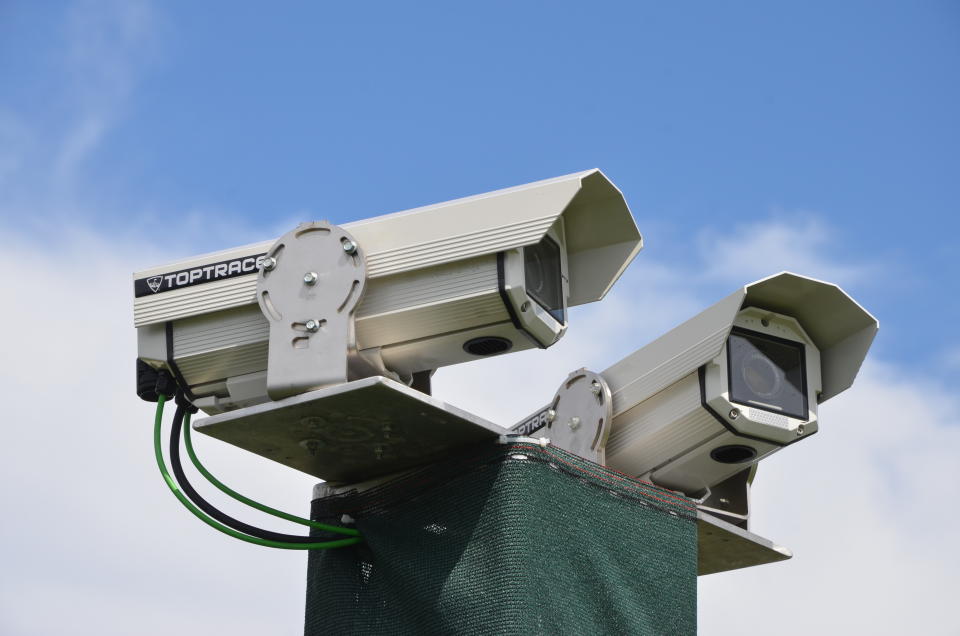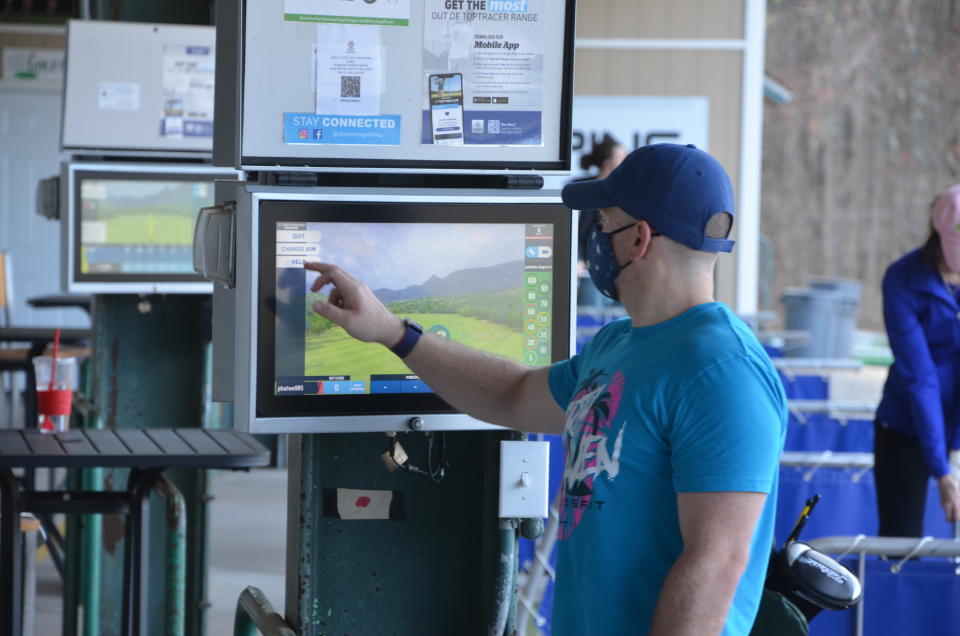The Connected Golfer: How to utilize new range technology that tracks shots, gathers data

The Connected Golfer is a new, multi-part series that examines how advancements in technology and new products are allowing golfers to connect and share information gathered on the range, on the course, during lessons and in equipment-fitting sessions like never before. By applying real, personalized data to lessons, rounds and club fittings (no more guessing and buying off the rack!), golfers can make better decisions and more easily monitor their progress. Learn how to gather information and how to use it in conversations with coaches and club fitters, and you’ll get better, quicker, and have more fun doing it.
In the first installment, we introduce you to the practice area of the future – one that’s here today.
The views at Spanish Hills Club in Camarillo, California, are stunning. The tricky course is perched on a hill above lemon orchards, strawberry fields and farmland. However, the best thing I can say about the Spanish Hills driving range is it’s ego-boosting. As you hit down a steep slope, your shots seem to hang in the air forever.
Across the country, the opposite is true at Baltusrol Golf Club in Springfield, New Jersey. A bastion of blue-blooded tradition, the club has hosted seven U.S. Opens, two U.S. Women’s Opens and two PGA Championships, but the members’ range slopes uphill, making shots fly shorter.
Golfers who want to improve their game spend a lot of time on driving ranges, but most facilities, whether they slope downhill, uphill or are flat, are not designed to provide a lot of feedback. Most just have flags fluttering at distances like 100, 150 and 200 yards. They are, essentially, empty fields where golfers typically hit a shot off a matt (or turf, if you’re lucky), roll another ball into place and then hit the same shot again, hoping to see a straighter flight and more distance.
But thankfully, with advancements in technology and a growing demand among golfers for more information about the shots they hit, systems like Toptracer Range and TrackMan Range can transform tired, little-used practice spaces into areas where you can learn almost as much about your shots as pros on the PGA Tour who regularly use launch monitors that cost as much as a car.
A new era of information
Chris Cote operated the pro shop at GolfQuest, a double-decker practice facility in Southington, Connecticut, for years before he bought the entire facility in 2019. GolfQuest benefits from a good location, directly off Interstate 84, and initially opened in 1997. There was nothing special about it until Cote installed Toptracer Range.
By utilizing a pair of high-definition cameras that were first developed to create shot-tracer patterns on golf broadcasts, the system can track shots hit from 66 different hitting bays.

Cameras on the practice range help collect data for players as they practice.
“Think about the technology that you get watching a football game on TV with the first down line and the technology that you get that makes the line calls in tennis,” said Ben Sharpe, Toptracer’s CEO. “That’s the technology that we’re using for Toptracer, which is our secret sauce.”
As the cameras follow the ball, Toptracer Range collects information like carry distance, total distance, shot height, launch angle, curvature and landing angle. But instead of creating a graphic for Golf Channel, CBS or NBC, Toptracer Range displays it on television screens positioned in every hitting bay. Downloading a free app on a smartphone or tablet allows a golfer to access that information directly from his or her device.

Toptracer has become a key element of golf broadcasts.
TrackMan Range, developed by the same Danish company that makes the popular TrackMan launch monitors used by pros, works in much the same way. A radar-emitting transmitter positioned at the back of the range follows a shot’s path, then sends information to an app on your smartphone or tablet where you can see all kinds of information.
Systems like Toptracer Range and TrackMan Range encourage effective and efficient practice. In a single session, you can easily discover the average carry distance with every club in your bag. These systems can also help you work on things like accuracy, consistency and feel.
For example, if you want to work on approach shots, instead of hitting at a flag that happens to be 125 yards away, you can pre-select any yardage you like and Toptracer Range or TrackMan Range will reveal how close you come to that distance. The systems will not only show you your shot patterns, they will reveal your most-common misses and tendencies, too.
If you are learning to shape shots, your eyes can tell you that a ball is moving from right to left, but Toptracer Range and TrackMan Range can reveal exactly how much your shots curved, and how much they rolled out after landing.
There’s no guesswork here, just hard numbers.
An extra benefit is that Toptracer Range and TrackMan Range save all the data collected during your sessions in the system, so you can review your shots on your smartphone, tablet or desktop computer later. You can also share the information and findings, and that’s when things can get really interesting.
Knowledge is power
Golfers can take the information they learn on shot-tracking-enabled ranges and put it directly to use on the golf course. For example, if you know that your 6-iron has flown an average of 150 yards over the course of five practice sessions, when you’re faced with a par 3 that requires a 155-yard carry, picking a 5-iron will be an easier decision to make. Similarly, if you know from shot-tracking range sessions that hitting a half-swing sand wedge sends the ball 45 yards and makes it stop quickly, you can reach for that club more confidently the next time you are forced to play from that awkward distance.
If you are taking lessons, it is one thing to tell your PGA of America instructor or pro that you practiced three times since your last meeting, but it is another to show him or her data from each of those sessions. When an instructor can see tracer patterns of your shots and view your dispersion patterns with each club, he or she can get a better feel for how you are progressing.

A player browses shot data at Chris Cote’s range in Southington, Connecticut.
Likewise, sharing information you gather on shot-tracking-enabled ranges can help club fitters get a better understanding of your tendencies and the distance gaps between your clubs the next time you need new gear. Instead of relying solely on the shots you hit that day during your fitting, the fitter can consider a much larger number of shots and make better recommendations for you.
For the facility, shot-tracking systems offer benefits too. According to Toptracer, 90 percent of the facilities that add Toptracer Range see an increase in new golfer visits, with 74 percent of golfers going to those facilities specifically because they have Toptracer Range. To help facilities afford the equipment and costs associated with installing Toptracer Range, the company offers a five-year leasing program, but according to Sharpe, many ranges become cash-positive within the first month of operation because of the increased traffic.
“The Southington location has been absolutely insane,” Cote said. Even in the midst of a cold New England winter, with the range itself covered with snow, heaters and covers above the hitting bays have kept things, in Cote’s words, overwhelming.
After Toptracer was installed, Cote utilized Facebook and Instagram to get the word out about the upgrades to his facility, but after six months he stopped. The word was out and his business was thriving.
Cote opened a second Toptracer location in Portland, Connecticut, in June 2020 and said that with no advertising, within a month the range was packed.

Hitting bays at Chris Cote’s range in Southington, Connecticut.
“The younger kids absolutely love it,” he said. “I think they almost prefer it over playing golf. I really do. They hang out with their buddies, have a couple of drinks and don’t have to worry about the group behind them. They can play music. It’s fun!”
The bottom line is this: Empty-field, traditional driving ranges are still the norm, but as you can see by clicking on these maps, (here and here), there are lots of facilities where you can track your shots and gather data easily. More are coming soon, and in time, golfers at every level are going to practice more effectively and use what they learn in those practice sessions to become better golfers.

